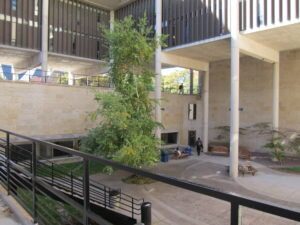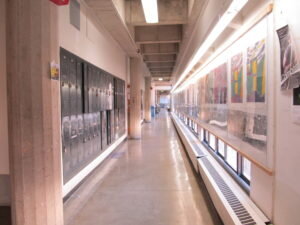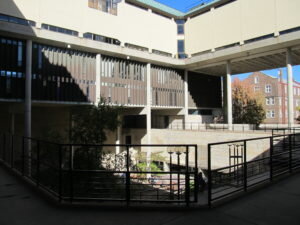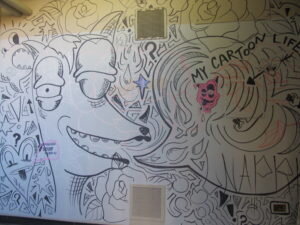A Brutalism Apologist Speaks
Exposure to the theory that the George L. Mosse Humanities Building is riot-proof has become as much of a rite of passage in the life of the common UW Madison student as getting lost in the maze-like structure itself.Yet, the Humanities Building, designed by Harry Weese, opened in 1969 as a socially progressive work of art. Regardless of the dystopian shroud of myth ascribed to it over time, Weese created the building as a utopian monument through his Brutalist architectural lens. Brutalism, an architectural movement spanning from the 1950s to the mid-1970s, produced a large amount of gargantuan, fortress-like buildings marked by use of exposed concrete. Brutalist structures place an emphasis on geometric form and holistic function, highlighting human uses of space. The Humanities Building has long held the title of “Academic Building We Love to Hate” for many at the University of Wisconsin Madison, students and staff alike. I can easily recall the visceral reactions of my peers to the revelation that I had a class in Humanities and the warning of its unwieldiness that always accompanied their aversion. Such a response to the hulking building is justified. Despite heeding my friends’ advice and arriving a half an hour early so as to navigate the innards of Humanities, I found myself utterly disoriented once I first set foot inside.For starters, each of the innumerable entrances is incredibly nondescript, yet the choice impacts the parts of the building that can be readily accessed. I made a novice mistake and started up a stairwell that cut off three floors earlier than I needed it to. I tried another entrance, another stairwell, accosted random passersby – the whole experience was incredibly humbling. I truly felt like the freshman I was. Eventually, I made it up to my destination, late, sobered by the seeming structural disorderliness of such an aesthetically orderly building.My classmates and I fostered a sense of unity through our shared struggle in navigating the concrete colossus. My T.A. first mentioned the supposed lore of the building, citing the separation of the men’s and women’s bathrooms on different floors, the incongruity of dead-end staircases and hallways, and the overall fortress-like appearance as hallmarks of a riot-proof building. It is commonly believed that the “counterintuitive” divisions of so many areas are meant to discourage students from congregating during violent protests, inhibiting movement inside and out of the building. The fact that the place was designed during the socially-tumultuous 1960s lends credence to this theory.
The Humanities Building has long held the title of “Academic Building We Love to Hate” for many at the University of Wisconsin Madison, students and staff alike. I can easily recall the visceral reactions of my peers to the revelation that I had a class in Humanities and the warning of its unwieldiness that always accompanied their aversion. Such a response to the hulking building is justified. Despite heeding my friends’ advice and arriving a half an hour early so as to navigate the innards of Humanities, I found myself utterly disoriented once I first set foot inside.For starters, each of the innumerable entrances is incredibly nondescript, yet the choice impacts the parts of the building that can be readily accessed. I made a novice mistake and started up a stairwell that cut off three floors earlier than I needed it to. I tried another entrance, another stairwell, accosted random passersby – the whole experience was incredibly humbling. I truly felt like the freshman I was. Eventually, I made it up to my destination, late, sobered by the seeming structural disorderliness of such an aesthetically orderly building.My classmates and I fostered a sense of unity through our shared struggle in navigating the concrete colossus. My T.A. first mentioned the supposed lore of the building, citing the separation of the men’s and women’s bathrooms on different floors, the incongruity of dead-end staircases and hallways, and the overall fortress-like appearance as hallmarks of a riot-proof building. It is commonly believed that the “counterintuitive” divisions of so many areas are meant to discourage students from congregating during violent protests, inhibiting movement inside and out of the building. The fact that the place was designed during the socially-tumultuous 1960s lends credence to this theory. Yet, historical context lends necessary understanding to the Brutalist perspective exemplified by the Humanities Building. By looking to the past, the features that appear “riot-proof” at surface-level can be demystified and identified as manifestations of modernist expression. As seen in much of modernist art, the horrors of World War II greatly affected the collective human psyche. Brutalism was a reaction by younger generations to the “lightness, optimism, and frivolity” of structures popularized before the war. In light of the life-altering atrocities of WWII, these old structures were considered no longer “true” to the human experience.Philosopher Theodor Adorno’s famous quote, “Writing poetry after Auschwitz is barbaric,” applies to Brutalist architecture as it does the paintings of Mark Rothko and Jackson Pollock. Such modernist artists felt they had to abandon all conventions of artmaking in order to deal with the depths of emotion they found were no longer represented by the works of the past. Brutalism overturns bourgeois detachment inherent in the Beaux-arts architecture of the elite by becoming its antithesis. Thus, it creates an unpretentious space that the masses can use collectively. Rather than coldness and vacancy, Brutalism aims to portray a sense of moral honesty in both function and form – again, emphasizing the human use of public space.The overall linking of the Humanities Building to so many other places on campus is worth noting as it enables human movement and interaction. The pedestrian bridge and connectedness of both the Conrad A. Elvehjem Building and the Chazen Museum of Art to the Humanities Building exemplify such social implementations. This facilitation – rather than perceived suppression – of social spatial usage is also exhibited by the centrally-located courtyard. The various entrances to the building culminate at this central terminus of open air and green space. I was lucky enough to catch the school band playing renditions of cinematic theme songs in the central area last spring, joining crowds of other happy students to appreciate my peers’ artistry. The copious exposed walkways encircling the building allow one to overlook said courtyard and provide places for people to relax communally on built-in benches between classes.
Yet, historical context lends necessary understanding to the Brutalist perspective exemplified by the Humanities Building. By looking to the past, the features that appear “riot-proof” at surface-level can be demystified and identified as manifestations of modernist expression. As seen in much of modernist art, the horrors of World War II greatly affected the collective human psyche. Brutalism was a reaction by younger generations to the “lightness, optimism, and frivolity” of structures popularized before the war. In light of the life-altering atrocities of WWII, these old structures were considered no longer “true” to the human experience.Philosopher Theodor Adorno’s famous quote, “Writing poetry after Auschwitz is barbaric,” applies to Brutalist architecture as it does the paintings of Mark Rothko and Jackson Pollock. Such modernist artists felt they had to abandon all conventions of artmaking in order to deal with the depths of emotion they found were no longer represented by the works of the past. Brutalism overturns bourgeois detachment inherent in the Beaux-arts architecture of the elite by becoming its antithesis. Thus, it creates an unpretentious space that the masses can use collectively. Rather than coldness and vacancy, Brutalism aims to portray a sense of moral honesty in both function and form – again, emphasizing the human use of public space.The overall linking of the Humanities Building to so many other places on campus is worth noting as it enables human movement and interaction. The pedestrian bridge and connectedness of both the Conrad A. Elvehjem Building and the Chazen Museum of Art to the Humanities Building exemplify such social implementations. This facilitation – rather than perceived suppression – of social spatial usage is also exhibited by the centrally-located courtyard. The various entrances to the building culminate at this central terminus of open air and green space. I was lucky enough to catch the school band playing renditions of cinematic theme songs in the central area last spring, joining crowds of other happy students to appreciate my peers’ artistry. The copious exposed walkways encircling the building allow one to overlook said courtyard and provide places for people to relax communally on built-in benches between classes. These socially-inclined spaces would likely not exist if the building’s purpose was to inhibit such togetherness. The spaciousness and minimalism of such public areas may distort their purpose, coming off as cold and vacuous. Yet, the Humanities Building functions as a “blank canvas” of sorts by providing communal areas marked by openness. They offer a sense of possibility – those utilizing them can do so in whatever way they see fit, unhindered by unnecessary ornament.The complaints about learning amidst Brutalist architecture are well-founded. Raw concrete is far from inviting. The overall lack of natural light throughout the building is striking. These problems are especially apparent on the lower floors. Individual classrooms feel more like bunkers than places well-suited for learning. The simplicity of design quickly becomes austere when one finds themselves in a small room with ten others drudging through a discussion section. Yet, the beauty of the building – though more clearly exhibited by the functions of its exterior – can be found inside as well, if not on the lowermost floors.To those who have never had the pleasure of visiting the arts floors (six and seven) in the Humanities Building, I recommend doing just that. It may just alter your view of the structure itself. The artistically-inclined students seem to know something about the Humanities Building that the rest of the population doesn’t. They have actively engaged with the Brutalist “blank canvas,” colonizing the bare walls with their own work. The upper floors function as a gallery of sorts, displaying the fruits of their artistic effort and allowing students to appreciate the work of their peers as they pass through. This, in itself, is a social act – the Brutalist minimalism facilitates interaction with others by providing such a stage for the admiration of humanistic creations.
These socially-inclined spaces would likely not exist if the building’s purpose was to inhibit such togetherness. The spaciousness and minimalism of such public areas may distort their purpose, coming off as cold and vacuous. Yet, the Humanities Building functions as a “blank canvas” of sorts by providing communal areas marked by openness. They offer a sense of possibility – those utilizing them can do so in whatever way they see fit, unhindered by unnecessary ornament.The complaints about learning amidst Brutalist architecture are well-founded. Raw concrete is far from inviting. The overall lack of natural light throughout the building is striking. These problems are especially apparent on the lower floors. Individual classrooms feel more like bunkers than places well-suited for learning. The simplicity of design quickly becomes austere when one finds themselves in a small room with ten others drudging through a discussion section. Yet, the beauty of the building – though more clearly exhibited by the functions of its exterior – can be found inside as well, if not on the lowermost floors.To those who have never had the pleasure of visiting the arts floors (six and seven) in the Humanities Building, I recommend doing just that. It may just alter your view of the structure itself. The artistically-inclined students seem to know something about the Humanities Building that the rest of the population doesn’t. They have actively engaged with the Brutalist “blank canvas,” colonizing the bare walls with their own work. The upper floors function as a gallery of sorts, displaying the fruits of their artistic effort and allowing students to appreciate the work of their peers as they pass through. This, in itself, is a social act – the Brutalist minimalism facilitates interaction with others by providing such a stage for the admiration of humanistic creations. Beyond that, even, the artists on campus have made the space their own by taking advantage of the more informal possibilities provided by the Brutalist simplicity. The whitewashed walls have effectively become places for students to draw, paint, or jot down musings. Graffiti and stream-of-consciousness scrawlings become opportunities for students to collaborate, carrying on wall-based conversations through their additions to the work others leave behind. The sixth and seventh floors are dynamic, changing with the students that inhabit them. The faculty have even promoted this interaction with the bare space by assigning mural projects in elevator lobbies, allowing students to work together to create a communal artistic vision and an aesthetic experience for others to enjoy.This embrace of Brutalist emptiness as an opportunity for creative expression is wholly representative of the humanistic experience in itself. Students meet a blank “canvas” or “page” head-on and make something out of nothing. They add to the architectural incongruities with their own hands and minds, challenging others to overstep their inhibitions and participate in permanent and public expression as they have. They interact with each other over time through these acts of creation.Even so, the Humanities Building has been living on death row for at least 13 years now. Brutalism hasn’t aged well in the eyes of the public. Yet, somehow it has managed to evade the University’s plans for its destruction year after year. I find myself aligning with Ann Matthews, who, in the 2006 Preservation Magazine article “Embracing the Brute,” said, “Even when you felt most lost most trapped, you never forgot you were wandering inside a gigantic work of art.” The George L. Mosse Humanities Building is an unapologetic presence, but I find myself an active apologist for its cause. Its Brutalist minimalism allows one to focus, unhindered, on the essence of the humanities: human interaction and the act of creation. I hope this misunderstood, interactive artwork continues to cheat death for years to come.
Beyond that, even, the artists on campus have made the space their own by taking advantage of the more informal possibilities provided by the Brutalist simplicity. The whitewashed walls have effectively become places for students to draw, paint, or jot down musings. Graffiti and stream-of-consciousness scrawlings become opportunities for students to collaborate, carrying on wall-based conversations through their additions to the work others leave behind. The sixth and seventh floors are dynamic, changing with the students that inhabit them. The faculty have even promoted this interaction with the bare space by assigning mural projects in elevator lobbies, allowing students to work together to create a communal artistic vision and an aesthetic experience for others to enjoy.This embrace of Brutalist emptiness as an opportunity for creative expression is wholly representative of the humanistic experience in itself. Students meet a blank “canvas” or “page” head-on and make something out of nothing. They add to the architectural incongruities with their own hands and minds, challenging others to overstep their inhibitions and participate in permanent and public expression as they have. They interact with each other over time through these acts of creation.Even so, the Humanities Building has been living on death row for at least 13 years now. Brutalism hasn’t aged well in the eyes of the public. Yet, somehow it has managed to evade the University’s plans for its destruction year after year. I find myself aligning with Ann Matthews, who, in the 2006 Preservation Magazine article “Embracing the Brute,” said, “Even when you felt most lost most trapped, you never forgot you were wandering inside a gigantic work of art.” The George L. Mosse Humanities Building is an unapologetic presence, but I find myself an active apologist for its cause. Its Brutalist minimalism allows one to focus, unhindered, on the essence of the humanities: human interaction and the act of creation. I hope this misunderstood, interactive artwork continues to cheat death for years to come.